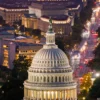What RIAs can learn from the institutional experience
The wrong asset allocation calls can be costly, and ignoring certain asset classes, such as private equity, private credit, and real estate, can come at a steep price. This lesson has been starkly illustrated by the recent U-turn of CalPERS, the largest public pension plan in the US, which recently increased its private market allocations to 40% of its total asset allocation.
This marks a steep revision from CalPERS’s previous stance, which effectively put its private equity allocation program on hold between 2009 and 2018. – a move that officials now admit cost up to $18bn in returns.1
CalPERS’ analysis demonstrated that its private equity portfolio’s 20-year annualized returns stood at 12.3%, making it the top-performing asset class within the fund over that period. ‘The returns from private equity over a five-year and 10-year period also outpaced every other asset class as of the end of 2023,’ a fund spokesman said.2
What’s more, CalPERS official asset allocation review concluded that private equity remains the asset class with the highest expected long-term total return going forward. This suggests that even in a more challenging, higher interest environment, the asset class could still deliver robust returns for investors.
CalPERS, which manages a colossal $440bn in assets for two million Californians, is not the only pension fund to overhaul its strategy after a thorough review of past missteps. Japan’s Government Pension Investment, Norway’s Government Pension Fund and National Pension South Korea all increased their private asset allocations.
Private assets: inflation-linked and alpha driven
For decades, private assets have been primarily the domain of institutions and the super wealthy. But today, disruptive technology solutions have brought them into the ambit of advisors. This is particularly important in today’s changed market environment.
‘Private credit investments are inflation-linked. They are structured as floating-grid instruments. So structurally, investors can capture the upside that comes with higher interest rates, which can benefit investor portfolios in today’s market both in the long term and short term,’ said Kunal Shah, Managing Director, Head of Private Asset Research and Model Portfolios at iCapital.
Meeting client needs: how private assets can help advisors
The enhanced yields on offer can be particularly relevant in meeting the specific needs of RIA clients- for example, the need for income. ‘What is private credit if not income enhancement in a portfolio? When you think about the managers that have emerged in this space, that can drive yields of 11-12%, there are some innovative credit managers that can offer different returns than traditional mutual funds or SMA managers.
‘Alternative securities may have lower liquidity profiles and should be viewed as offering total return-risk /return profile, and the question is whether the potential return makes that lower liquidity profile acceptable,’ explained Shah. ‘Then there’s private equity.’
‘Private equity offers an activist approach in contrast to public equity markets which are increasingly index-driven, with a lot of money moving to passive strategies. This can be a tremendous source of alpha and that’s what we hold our hat on.’
Why public markets investors are missing out
If yet another incentive for investors to buy private equity was needed, the global supply of public equity has been steadily shrinking according to the latest research by analysts at JP Morgan. There’s been a net reduction of $120bn in public equities this year alone, a figure that dwarfs last year’s $40bn decrease and marks the third consecutive year of decline. This is thanks to the growing trend for companies to stay private for longer, as well as an increase in share buybacks. Importantly, it means that advisors who invest only in public markets could be missing out on a broad spectrum of growth opportunities.
All alternative assets are not the same
At the same time, alternative assets can offer diverse income streams, often with relatively low correlations. For example, real estate investments can offer stability and steady income through rental yields, as well as potential for significant capital appreciation. Moreover, real estate often acts as a hedge against inflation, preserving the purchasing power of invested capital over time.
All alts are not the same: Research and due diligence remain the key
Due diligence and extensive research remain the key to unlocking returns, especially in private markets. Today, with a large number of managers with seemingly under-differentiated offerings and heavily gravitating performance profiles across both ends of the spectrum, expert knowledge and experience are more important than ever.
The onus is on advisors
‘RIAs are performing analysis for their clients on these private offerings by leveraging a combination of internal and external resources. This analysis is important given the limited liquidity for many of these offerings Advisors have to make an active decision to invest or not to invest. If they choose not to invest, they need to explain to their clients why they have decided against it.’ said James Costabile, Managing Director for Alternatives Distribution at iCapital.
Since the removal of wrappers, there’s been much concern about what can be bought in taxable versus tax-exempt accounts, coupled with the fact that the client qualification has moved down from what was normally a qualified purchaser domain to an accredited investor to even sub-accredited investor, this has been a game changer for advisors to really pay attention to.’
*April 2, 2024, S&P Global Market Intelligence data
















